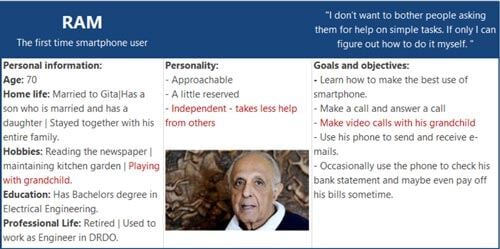Consider that you are writing a user guide for the latest smart phone that is launched in the market. You know that billions of people across the world could be prospective buyers; people from different walks of life, people of different age groups and people with different mobile usage skills.
And, you want your document to satisfy all your user’s needs!
Is that even possible? Where do you start?
What if you started by classifying your target audience (smartphone users) into 3 groups based on their age? For example, Senior citizens (55 and above), Middle-aged adults (36 to 55 years), and young adults (18 to 35 years). And then, you then picked a representative from each group who you think would be a typical smartphone consumer in that group. What if you now designed your document based on the needs of those three people? Wouldn’t that be much easier?
That representative in each group that you pick, qualifies to be a Persona.
Defining a Persona
Personas are archetypes built to identify real users’ profiles, needs, wants and expectations in order to design the best possible experience for them.
A persona is depicted as a specific person but is not necessarily a real individual; rather, it is synthesized from the observations of many people, in this case, many prospective smartphone consumers in the specific age group.
So, what does a persona look like?
While a persona is usually a one-pager document, it is more than just a deliverable. What’s more important is that it provides a fundamental understanding of a user in the group.
Let’s take an example.
Meet Mr. Ram, a prospective smartphone consumer, who is a senior citizen.

From Mr. Ram’s persona above, we can gather that:
- He is a first time smartphone user, which gives a clue on the level of detail he would look for in a smartphone user guide.
- He prefers doing things independently. Notice when he says “I don’t want to bother people asking them for help on simple tasks. If only I can figure out how to do it myself.” So, he is the type who would read up available help material before he asks friends, family etc.
- He really looks forward to making video calls to his grandchild abroad, meaning he has a real need to buy the smartphone, and he most likely will.
How Are Personas created?
Personas can be created in a myriad of ways, but you could follow this general formula:
- Interview and/or observe an adequate number of people.
- Find patterns in the interviewees’ responses and actions, and use those to group similar people together.
- Create archetypical models of those groups, based on the patterns found.
- Record your persona.
- Drawing from that understanding of users, create user-centered documentation.
- Share those models with other team members and stakeholders.
Why Personas?
- To build empathy: When you create a persona, you are crafting a lens through which you can see your user’s world. With those glasses on, you gain a perspective similar to theirs.
- Develops focus
Personas help you to define who the documentation is being created for and who not to focus on.
- Helps communicate and form a consensus
A persona, as a deliverable, helps to communicate research findings to people who were not able to be a part of the interviews with users. When all team members share the same understanding of their audience, then building a consensus on important issues becomes easier.
- Helps make and defend decisions
Just as personas help to prioritize who to design for, they also help to determine what to design for them. When a design choice is brought into question, defending it based on real data and research on users (as represented by the persona) is the best way to show others the logical and user-focused reasoning behind the decision.
- Measures effectiveness
Personas can be stand-in proxies for users when the budget or time does not allow for testing with real users. If someone who is play-acting a persona cannot figure out how to use a feature or gets frustrated, then the users they represent will probably have a difficult time as well.
-
The bottom-line
Designers don’t always know what is best — but sometimes users do and that is what personas are for: to stand up and represent real users, since real users can’t be there when the design process takes place.
In your next project, consider how personas can ensure success, and satisfy the needs of all users!


